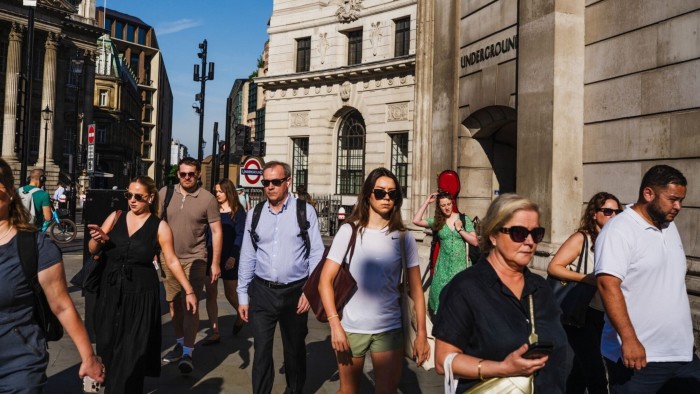The UK faces “daunting” risks to the public finances as its soaring debt load leads to “substantial erosion” of its capacity to respond to future shocks, the independent budget watchdog has warned.
The Office for Budget Responsibility said on Tuesday that efforts to put the UK on a more sustainable fiscal footing have met with only “limited and temporary” success in recent years.
Underlying public debt, which is at its highest since the early 1960s, is set to rise further, the OBR warned. It added that addressing the issue had become “considerably more challenging” given low economic growth and rising interest rates.
The pound fell as much as 0.6 per cent against the dollar as the report fuelled worries about the UK’s public finances. It was later down 0.2 per cent.
Investors sold gilts, pushing 10-year borrowing costs up 0.04 percentage points to 4.63 per cent.
“Against this more challenging domestic and global backdrop, the scale and array of risks to the UK fiscal outlook remains daunting,” the watchdog said in its fiscal risks and sustainability report.
“The result has been a substantial erosion of the UK’s capacity to respond to future shocks and growing pressures on the public finances,” it added.
The report comes as chancellor Rachel Reeves faces renewed pressure to raise taxes in the autumn Budget following signs of a further deterioration in the health of the public finances.
U-turns on welfare reforms coupled with strains on the UK economy and the threat of productivity downgrades from the OBR could force tax rises or spending cuts exceeding £20bn in the autumn, economists say.
Downing Street said: “The government is getting the public finances under control but we recognise the realities set out in the OBR report.”
The OBR noted that the UK now had the sixth-highest debt, fifth-highest deficit and third-highest borrowing costs among 36 advanced economies.
Unlike many other big economies, the UK has not pared back public debt after it rose during the Covid-19 pandemic and energy crisis, leaving the country’s situation “increasingly vulnerable” by international standards, the watchdog said.
Rising public borrowing in the UK and other advanced economies is creating wider pressures in global sovereign debt markets, it added.
The OBR noted that borrowing costs have risen further because long-term gilt yields are higher in the UK than at any time since the start of the century.
Gilts sales by domestic pension funds could also put pressure on borrowing costs as savers transition from defined benefit to defined contribution schemes. The watchdog projected that UK pension fund ownership of gilts will fall from almost 30 per cent of GDP in 2025 to 11 per cent by 2074.
It added that higher interest rates would be needed to “entice” buyers such as overseas investors into the UK gilt market if the pension sector’s holdings decline. This could eventually increase debt interest spending by £22bn a year in today’s terms, the OBR found.
It also forecast that spending on the state pension — the second-largest item in the government budget after health — would rise from almost 5 per cent of GDP to 7.7 per cent by the early 2070s.
The forecast is based on a continuation of the so-called “triple lock”, which was introduced by the 2010 coalition government and ensures the state pension increases every year by consumer price rises, average earnings growth or 2.5 per cent, whichever is highest.
Labour has faced criticism of its pledge to protect the policy, as ministers prepare to launch a review into pensions adequacy.
The OBR found that because of inflation and earnings volatility, the triple lock is on track to cost about three times more than initial expectations by 2029-30.
The watchdog also highlighted additional pressures from the costs of climate damage and the net zero transition, as well as risks stemming from US President Donald Trump’s trade war and rising defence commitments.
A key near-term risk for Reeves is productivity growth, which is crucial to the fiscal outlook given its importance for tax revenue.
In a press conference, Richard Hughes, OBR chair, noted that just a 0.1 percentage point reduction in the OBR’s productivity growth forecast over five years would wipe out Reeves’ £9.9bn of headroom against her key fiscal rule.
The chancellor has pledged that day-to-day spending will be matched by tax revenues by 2029-30.
The OBR predicts that productivity growth will reach 1.25 per cent by 2029-30, compared with Bank of England projections for medium-term productivity growth of 0.75 per cent a year.
David Miles, another member of the OBR’s steering committee, acknowledged that the fiscal forecaster’s productivity outlook was more optimistic than those of many other economists.
While productivity growth used to be around 2 per cent a year before the financial crisis, it has been just 0.5 per cent since then, in part because the UK has been hit by a series of shocks, he said.
The key question, he said, was whether the UK would return to more historically normal growth rates or continue to see “rubbish productivity growth”.
Responding to the report, the Treasury said: “We recognise the long-standing economic realities the OBR sets out.”
“This is why we are committed to ensuring stability in the economy through our non-negotiable fiscal rules, which have allowed us to invest in the UK to drive a decade of renewal and put more money in people’s pockets,” it added.
Additional reporting by George Parker and Ian Smith
Data visualisation by Janina Conboye
